Many people think of Catholic weddings as a celebration with the Bible and a priest officiating at the ceremony. However, it’s not just that! Undoubtedly, catholic weddings are full of time-honored customs. But these weddings are fun-filled events.
If you’re not familiar with religious traditions and etiquette, this is the post for you. In this post, we shall describe everything about Catholic Wedding Ceremony.
Just scroll down to read the full articles and gain insights on catholic weddings.
Here we go…
You can opt for a Catholic wedding liturgy with or without a mass. While many devout Catholics choose to have a wedding Mass as part of their ceremony, others do so to offer their marriage an extra blessing.
There are a number of pre-wedding, wedding, and post-wedding rituals that are happily carried out in a typical Catholic wedding.
A traditional Catholic wedding ceremony involves a full mass and communion, which can take up to an hour to complete. Some to-be-weds prefer to only have a Rite of the Marriage ceremony (which doesn’t include a mass). It can last anywhere from 30 to 45 minutes.
So, let’s take a look at the different catholic wedding rituals.
Pre-Wedding Rites
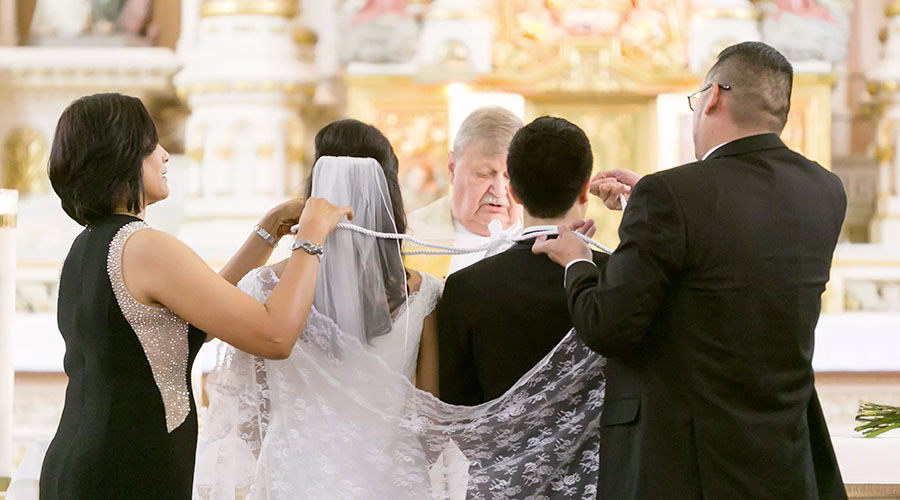
Engagement
The first and foremost pre-wedding ritual that takes place is engagement. The groom and his family pay a visit to the bride’s home, in accordance with the custom widespread among Catholic Christians.
The parish priest blesses the engagement rings that the bride and the groom exchange. The engagement ceremony marks the beginning of a period in which the boy and girl will come to know one another more intimately.
Participating in a Preparatory Program
Once the couple is engaged, their wedding date is fixed. However, after their engagement, the couple is needed to attend a Marriage Preparatory Course before getting married. They can select between a one-day and a three-day course to suit their needs.
Marriage preparation programs assist couples in comprehending the Christian and human dimensions of marriage. Typical subjects include the significance of marriage as a sacrament; faith, prayer, the church; roles in marriage; communication and conflict resolution; parenthood, Natural Family Planning; children, money; and family of origin.
Participants in this seminar must fill out a form detailing their personal information and swear on the Holy Bible that they have not omitted any information about their lives in order to be admitted.
In addition, they must provide copies of their baptismal certificates. Every Sunday for three consecutive Sundays, the priest announces the decision of the boy and girl to get married in the church.
Anyone can request that information be made public within this time period if they believe that one of the parties has concealed or misrepresented information. The couple will be able to marry only when the three-week waiting period is over.
Bridal Shower
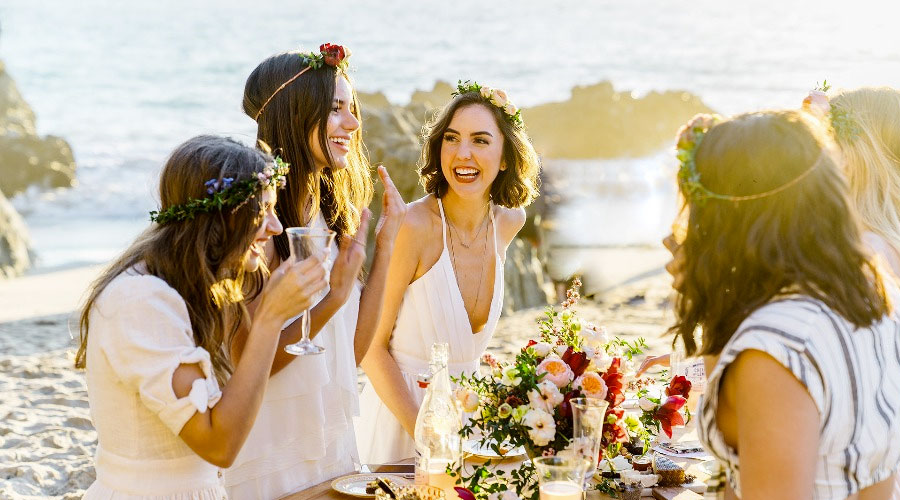
Like other brides, catholic brides also have a bridal shower. The bride’s family members perform the Bridal Shower ceremony. The Bridal Shower is, in essence, the last celebration that the bride throws for her female friends and relatives while she is still a maiden.
This is given to all of the bridesmaids as a gift of appreciation for their efforts. While participating in this ceremony, the bride distributes gifts to her bridesmaids and serves a pink cake that contains an unintentional thimble.
Apparently, the girl who receives the piece of cake with the thimble will be the next to get married.
Bachelor Party and Bachelorette Party
Essentially, the Bachelor Party is a stag party hosted by the groom’s friends on the eve of his or her wedding. The groom is anticipated to have a good time during this celebration, considering it will be his last night as a bachelor.
Similarly, the bride’s friends arrange a Bachelorette Party for her. They all enjoy their time and create wonderful memories of the day. Bridesmaids typically organize this day to celebrate friendship, love and growing up together.
The D Day
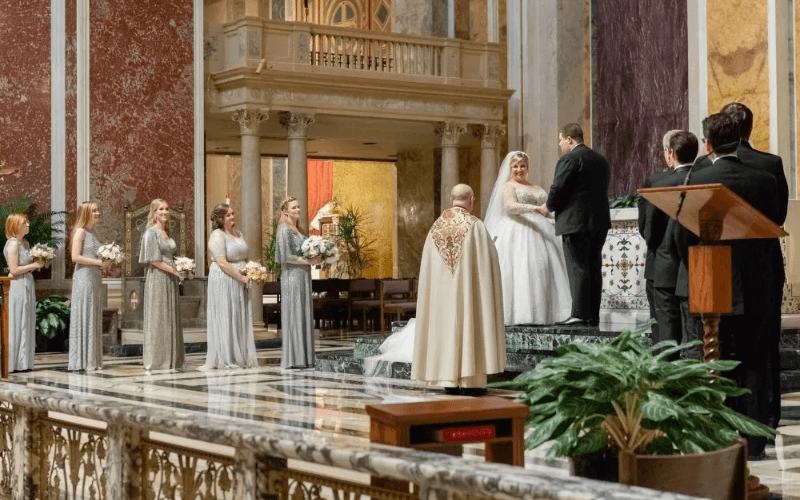
The Procession
First, the groom and best man make their way into the church. Following that, the bridesmaids and groomsmen make the entry, followed by the maid of honor. Finally, but certainly not least, the bride and her father (or another male member of the family) make their spectacular entrance into the ceremony.
Upon entering the church, the best man, who is a member of the bridegroom’s party, meets her with a kiss and the bride’s wedding bouquet.
In the next moments, the priest leads the couple into the church. The bride and groom are welcomed into the church by the choir, who sings a special song for them. The wedding couple will be seated on two beautifully decorated chairs in front of the altar.
The Priest’s Salutation
The priest welcomes the wedding guests and invites everyone to sing the opening hymn (or song), which is typical “Gloria” A Christian song also known as the Greater Doxology (in contrast to the “Minor Doxology” or Gloria Patri) and the Angelic Hymn/Hymn of the Angels. The priest will then give an opening prayer for the newlyweds once the ceremony is through. The congregation remains standing throughout the processional, hymn, and opening prayer. After the priest has concluded, guests may take their seats.
Liturgy of the Word
The priest and the guests (most of them) recite readings at the Liturgy of the Word. It begins with the reading of an Old Testament chapter. Frequently, couples select a reading from the book of Genesis, which includes the account of Adam and Eve’s creation. The cantor and congregation will then either read or sing from the Psalms. Responsorial psalms are the response of the congregation to God’s word, with the cantor singing the verses and the congregation singing the responses (essentially the chorus). A friend or family member then reads from the New Testament, followed by the priest reciting a portion from one of the Gospels.
Rite of Marriage
These are the promises. They act as both a declaration of intent and permission on the part of each party receiving the marriage rites. The couple can either remember and recite the vows to one another, read them from a book, or have the priest read them and respond, “I do.” Wording may differ from church to church, but there is a common structure. Some priests even permit couples to make their own vows or add a few lines to the standard ones. The congregation will remain standing during the entirety of the Rite of Marriage or vow exchange and subsequent ring ceremony.
The entire congregation stands as the couple exchanges vows, proclaiming their love for one another. Actual vows differ by the church, but the core ones are as follows: “I (name) accept you (name) as my wife/husband.
Also See: Guide of Catholic Wedding Vows
I promise to be faithful to you in good times, bad, and in between. I shall love and respect you for the rest of my life.”
“Do you take (name) as your lawful wife/husband, to have and to keep, from this day forward, for better or for worse, for richer or for worse, in sickness and in health, to love and cherish till death do you part?” the priest asks.
Ring Exchanging
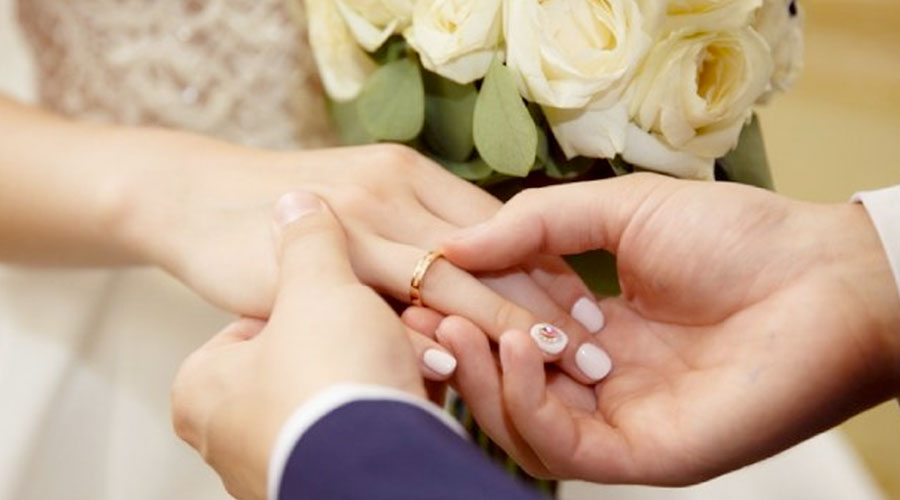
After the vows are exchanged, the best man usually brings the bride’s ring to the priest. The rings are then blessed by the priest as symbols of love and loyalty in the couple’s lives and hands it to the groom to place on the bride’s finger. The maid of honor then presents the groom’s ring to the priest, and the priest blesses it before passing it to the bride to be placed on the groom’s finger. “I take this ring as a sign of my love and faithfulness in the name of the Father, the Son, and the Holy Spirit,” each may say.
In addition, the priest may invite the couple to exchange a kiss at the signing of the peace or at the conclusion of the ceremony. The exchange of coins, known as las arras matrimoniales in some regions, is also a part of some regional customs. The couple, as well as their close family, approach the lectern (podium) and read passages from the Bible that have been previously selected.
Later, the priest delivers the Homily, which is a fascinating discourse that focuses on the sanctity of marriage as a central theme. The congregation stands only for the reading of the gospel, remaining seated for all other readings.
Catholic Wedding Ending Without a Mass
If the service does not include a Mass, it closes with nuptial blessings and a final prayer from the priest. “Go in peace with Christ,” he tells the crowd, to which they respond, “Thank you be to God.”
Catholic Wedding Finale: Mass
If the ceremony includes a Nuptial Mass (which adds around 15 minutes to the service), the Mass will follow the Catholic wedding traditions listed below. The order may differ slightly depending on the church, but each element should be present.
Offertory
This is the time when the altar is readied for communion, commonly known as the Eucharistic Liturgy. The couple or other special guests may be asked to assist with the preparations, and the priest then says the Eucharistic Prayers over the bread and wine for communion. In certain Catholic weddings, the bride sets flowers on the Blessed Virgin Mary’s shrine while musicians perform “Ave Maria.” This rite can be performed either before or after the processional.
The Lord’s Prayer
The visitors join in reciting the Lord’s Prayer from Matthew 6:9-13. “Hallowed be thy name, Our Father in heaven; thy kingdom comes; thy will be done on earth as it is in heaven. Give us our daily bread, and forgive us our transgressions as we forgive those who transgress against us; and lead us not into temptation, but rescue us from evil.”
Wedding Blessing
The wedding couple kneels or stands before the altar for this blessing, and the priest bestows a blessing on them.
Peace Sign
The priest invites the wedding party and guests to share a peace sign (usually a handshake) and the words “Peace be with you” with the persons standing closest to them.
Holy Communion
While the guests sing, the priest splits the host (bread), and communion is served to the newlyweds, then the guests, frequently with the assistance of servers. Guests who are not Catholic may be blessed instead by the priest.
Guests’ Blessing and Dismissal
The event concludes without a Mass after communion. The wedded couple and guests are given the last blessing before being dismissed with the words “Go in peace with Christ.” “Thank you, God,” guests respond.
Recessionary
The wedding couple leads the way out of the church, followed by the wedding party, the waiters, and finally, the priest.
Post Wedding Ceremony
The Wedding Reception
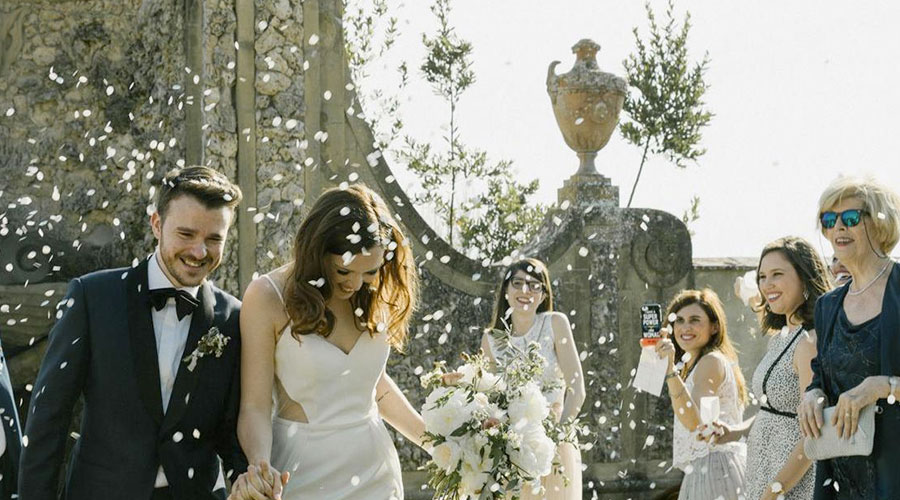
Following the wedding ceremony, there will be a wedding reception. Because the Catholic Church has defined times for hosting Mass, there may be a time lag between the conclusion of the service and the reception. Couples invite their friends, relatives, and coworkers to their wedding reception party.
The newlyweds cut the wedding cake and share a bite of the first slice of cake between them. The Toastmaster suggests a toast in honor of the newlyweds. Then, there will be a ‘first dance’ by the newlywed couple. With their ‘first dance,’ the bride and groom set the tone for the rest of the evening.
Following them are the bride and her father/groom and the bride’s mother, the bride and the best man/the groom and the maid of honor, the bride and the groom’s father/the groom and his mother, and the bride and the groom’s father/the groom and his mother.
Following the conclusion of supper, the couple departs from the reception. The bride must now fling her bouquet of flowers behind her as she walks down the aisle. In accordance with popular belief, the girl who catches the bouquet will be the next to marry.
Catholic Wedding FAQs
Q.1 What shall a couple do to get married in the Catholic Church?
Couples are required to offer at least six months’ notice to the priest or deacon who will be performing the ceremony. Although the law requires one month’s notice, the lengthier notice asked here provides for a more relaxed and serious approach to the preparations for marriage.
Q.2. What is the distinction between a legitimate and illegitimate Catholic marriage?
In the same way that individual states have requirements for legal marriage (such as a marriage license and blood tests), the Catholic Church has standards for Catholics to be regarded legitimately married in the eyes of the Church. For a Catholic marriage to be valid, four conditions must be met:
- The spouses must be free to marry;
- They must freely exchange their consent;
- They must have the intention of marrying for life, of remaining faithful to one another, of being open to children; and
- Their consent must be given in the presence of two witnesses and in the presence of a properly authorized Church minister.
The church authority must approve exceptions to the last condition.
Q.3. In the event that a Catholic wishes to marry someone who is not Catholic, how can they ensure that the Church would recognize the marriage?
In addition to satisfying the requirements for lawful Catholic marriage, a Catholic who wishes to marry a non-Catholic must obtain permission from the local bishop before doing so.
A “permission to enter into a mixed marriage” is what this authorization is referred to as if the person is a Christian who is not Catholic.
Whenever the individual is not a Christian, the permission is referred to as a “dispensation from the disproportion of the cult.”
Those who are assisting the couple in their preparation for marriage may be able to aid them with the permission process.
Q.4. Why is it necessary for a Catholic wedding to take place in a church?
For Catholics, marriage is more than just a social or family gathering; it is also a religious gathering. This is why the Church prefers that wedding ceremonies be held in the parish church of one of the spouses when they are between Catholics or between Catholics and other Christians.
Only the local bishop has the authority to provide permission for a marriage to be celebrated in a more appropriate location.
Q.5. If Catholic desires to marry in a location other than the Catholic Church, how can he or she be certain that the marriage will be recognized as valid by the Catholic Church?
If there is a compelling reason, the local bishop may grant permission for a wedding to be held in another church or in another suitable location.
Suppose a Catholic wishes to marry a Baptist whose father is the pastor of his local Baptist Church, and the father expresses interest in officiating at the wedding.
In these circumstances, the bishop may agree to allow the couple to exchange vows in the Baptist Church of their choice. A “dispensation from canonical form” is the term used to describe the authorization granted in these situations.
Q.6. What is the significance of a Nuptial Mass, and when can a couple opt for the same?
A Nuptial Mass is a celebration of the sacrament of marriage that takes place during a regular Mass. It contains particular readings and prayers that are appropriate for the celebration of the Sacrament of Marriage.
The celebration of the Sacrament of Marriage between two Catholics who have been baptized should generally take place at Mass.
It is permissible to sing a Nuptial Mass for a Catholic and a baptized person who is not a Catholic if the situation calls for it and the local bishop grants permission, but Communion is not administered to the non-Catholic because the general law of the church forbids it.
As a result, it is preferable in such cases to use the appropriate ceremony for marriage outside of Mass.
Q.7. In the event that a couple decides they wish to get married in the Catholic Church, what should they do next?
In order to prepare for marriage, they should call their parish as soon as possible and schedule an appointment with the priest, deacon, or other staff member who is in charge of preparing couples for marriage.
This individual will describe the process of marriage preparation, as well as the numerous programs that are available to participants.
Q.8. Why do engaged couples enroll in a marriage preparation program. Are these programs mandatory for all Catholic Couples?
If a couple chooses to get married in Catholic Church, attending Marriage preparation program becomes mandatory for them. These programs assist couples in comprehending the Christian and human dimensions of marriage. Typical subjects include the significance of marriage as a sacrament; faith, prayer, the church; roles in marriage; communication and conflict resolution; parenthood, Natural Family Planning; children, money; and family of origin.
It gives couples the opportunity to get a deeper understanding of Christian marriage, to examine and improve their readiness to live married life, and to gain insights into themselves as people and as a couple through marriage preparation.
It is particularly useful in assisting couples in coping with the difficulties that arise during the early years of marriage.
Q.9. Is there a variety of marriage preparation programs available through the church?
In some cases, various options may be available depending on the diocese and the parish. Programs may include a weekend program with other couples, such as Catholic Engaged Encounter, a series of sessions in big or small groups, or meetings with a married couple who has been married for a long time, among other things.
Some programs may be available in Spanish or other languages in addition to English. Individualized programs are designed to meet specific situations, such as remarriage, children brought into the marriage, and marriage to a non-Catholic partner.
Q.10. What is the fee for marriage preparation programs?
Usually, Catholic Church charge a small fee for these programs. It is just to cover the costs of the materials used. Programs that necessitate an overnight stay will incur an extra fee to cover the cost of food and accommodations.
The Bottom Line
So, this is all about the Catholic Wedding Ceremony. Hopefully, this article has been informative for you and help you have insights on Catholic Weddings!
Happy Wedding… ☺ ☺

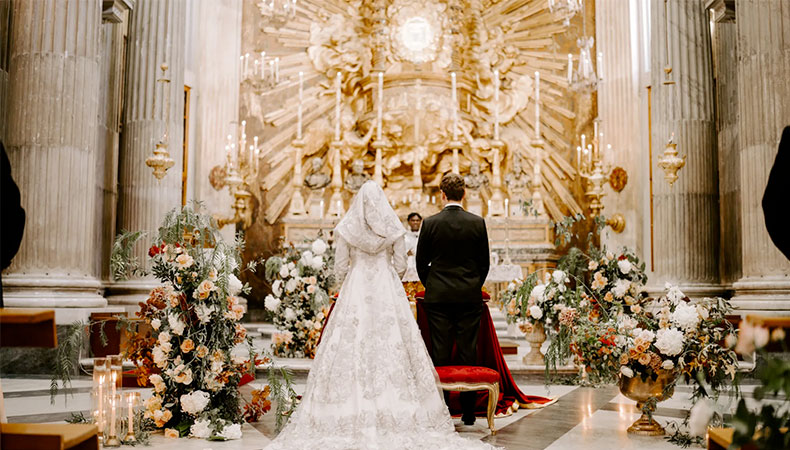
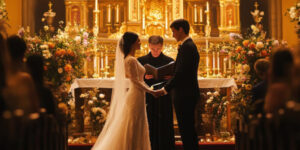



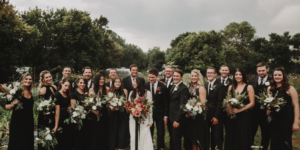
![20 Merry Christmas Wishes For Couple [2024-2025] 20 Merry Christmas Wishes For Couple [2024-2025]](https://www.happywedding.app/blog/wp-content/uploads/2024/10/Christmas-Wishes-For-Couple-300x150.jpg)